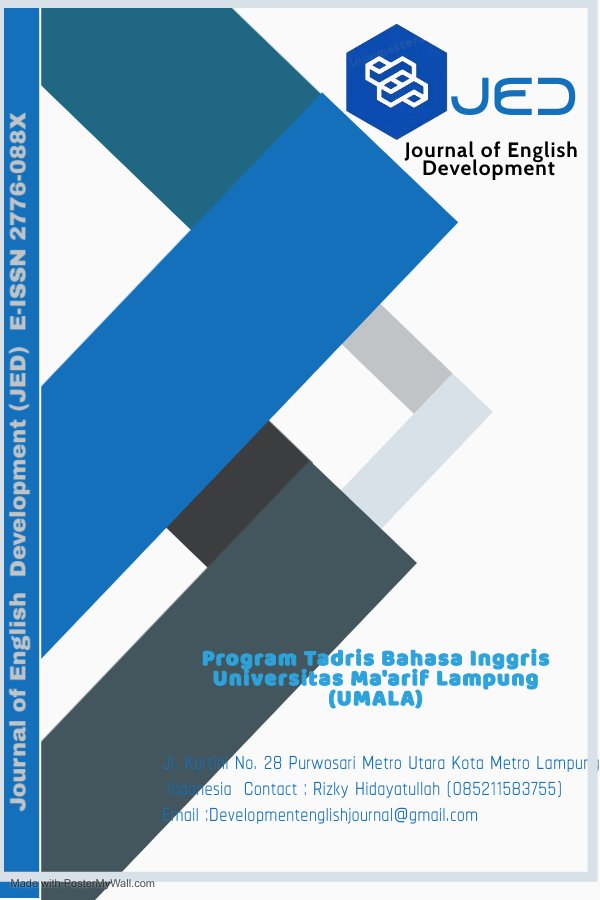A Probe Into The Comparison Of Human Translation And DeepL Translate In Translating English Text Into Indonesian
English
DOI:
https://doi.org/10.25217/jed.v4i02.4603Keywords:
Translation, DeepL Translate, Human Translation, Quality of TranslationAbstract
This research aims to analyze the difference between human translation and deep translation in translating English text into Indonesian. This research describes the accuracy, acceptability and readability of the results of human translation and translation tools. This research is a type of qualitative research, and the data source of this research is a short story text. The study involved two students of different genders enrolled in the English education program at Universitas Muhammadiyah Sumatera Utara. The researcher used the text document as an instrument tool, and the researcher will collect the results and descriptive data obtained from 4 stages: data collection, data reduction, data presentation, and conclusion drawing. The data reveals that women had an accuracy rate of 88%, while males achieved a rate of 56%. The acceptance level for language or words was 92% for females and 75% for males. The readability level achieved was 92% for females and 72% for males. Additionally, the researcher examined the degree of accuracy 88%, acceptability 88%, and readability 100% from the standpoint of DeepL Translate. From these results, we can conclude that the selection of translation tools is essential to help the translation process carried out by humans.
References
Ade. (2010). Machine Translation Is Not Human Translation. Copyright Ade Indarta 2016 - Designed by Site Origin. https://adeindarta.com/2010/06/02/terjemahan-mesin-bukan-terjemahan-manusia/
Al-Musawi, N. M. (2014). Strategic Use of Translation in Learning English as A Foreign Language (EFL) among Bahrain University Students. Innovative Teaching, 3, 4. https://journals.sagepub.com/doi/full/10.2466/10.03.IT.3.4
Aprianti, Y., & Ardi, H. (2023). An Analysis of Problems in Translating Descriptive Text from Indonesian to English by Sixth Semester of English Department Students of Universitas Negeri Padang. Journal of English Language Teaching, 12(3), 727-737.
Arrang, J. R. T., & Sallata, Y. N. (2018). Strategy in Writing in Constructing Paragraph in The Essay at Uki Toraja. Premise: Journal of English Education and Applied Linguistics, 7(2), 34-43.
Aswan, N. (2022). Metodologi Penelitian Pendidikan (1st ed.). Padang: PT. Global Eksekutif Teknologi.
Bender, E. M. (2022). Linguistic fundamentals for natural language processing: 100 essentials from morphology and syntax. Springer Nature.
Creswell, J.W. (2008). Educational Research : Planning, Conducting, and Evaluating Quantitative and Qualitative Research, Pearson Merrill Prentice Hall, Singapore. http://repository.unmas.ac.id/medias/journal/EBK-00121.pdf
Fitriani, N., Muhayyang, M., & Amri, U. (2022). Analisis Dampak Google Terjemahan pada Keterampilan Menulis Siswa.
Halimah, H. (2018). Comparison of human translation with Google Translation of imperative sentences in procedures text. BAHTERA: Jurnal Pendidikan Bahasa Dan Sastra, 17(1), 11- 29.
Hasibuan, Zainuddin. (2020). A Comparative Study Between Human Translation and Machine Translation as an Interdisciplinary Research. Journal of English Teaching and Learning Issues. 3(2).
https://journal.unj.ac.id/unj/index.php/bahtera/article/view/5774
Hurmaini, M. (2019). Study of Exposition Paragraph Development in Tarbiyah And Teacher Training Faculty Students. JURNAL TARBIYAH, 26(1).
Ivanova, V., & D Gladkova, O. (2018). Use Of Online Translators To Develop Translator’s Competence Of ‘Digital Natives’ Generation. European Proceedings of Social and Behavioural Sciences, 51.
Miles, M. B., & Huberman, A. M. (1994). Qualitative data analysis: An expanded sourcebook. sage.
Muhammad, F., Zaim, M., Syafei, A, F, R. (2017). An Analysis of Methods of Translation Used By The Third Year Student of English Department of Universitas Negeri Padang in Translating Short Narrative Text from English to Bahasa Indonesia. Journal of English Language Teaching. 6(1). https://ejournal.unp.ac.id/index.php/jelt/article/view/9665
Nababan, M. R., Ardiana, N., & Sumardiono. (2012). Pengembangan Model Penilaian Kualitas Terjemahan. Kajian Linguistik dan Sastra, 24(1), pp. 39-57.
Osman, Amira. (2017). Definition of Translation. Translation Journal. October 2017 Issue.
Pham,T. A.,Nguyen,Y. N.N.,et al. (2022). University Students’ Perceptions on The Use of Google Translate: Problems and Solutions.
Polakova, P.,& Klimova, B. (2023). Using Deepl Translator in Learning English as An Applied Foreign Language – An Empirical Pilot Study. Heliyon. https://doi.org/10.1016/j.heliyon.2023.e18595
Sakai, N. (2006). Translation. Theory, Culture & Society, 23(2-3), 71-78.
Sugiyono. (2015). Metode Penelitian Kuantitatif, Kualitatif, dan R&D. Bandung : ALFABETA.
Sujefri, A., Albadri, H. R. I., Zakiyah, A., & Basid, A. ( 2022 ). Analisis Sintaksis Kesalahan Penerjemahan Teks Bahasa Indonesia ke Bahasa Arab melalui Google Translate. Al-Muyassar: Journal of Arabic Education. 2(1). https://jurnal.umt.ac.id/index.php/al/article/view/6476
Surgawi, T., Joebagio., H., Djono. (2018). Analisis Kualitas Terjemahan Dari Bahasa Inggris Kedalam Bahasa Indonesia. Jurnal Penelitian Teknologi Pendidikan. 16(02).

Downloads
Published
How to Cite
Issue
Section
License
Copyright (c) 2024 RIKA VENNITA RIKA VENNITA, Yenni Hasnah

This work is licensed under a Creative Commons Attribution-ShareAlike 4.0 International License.





